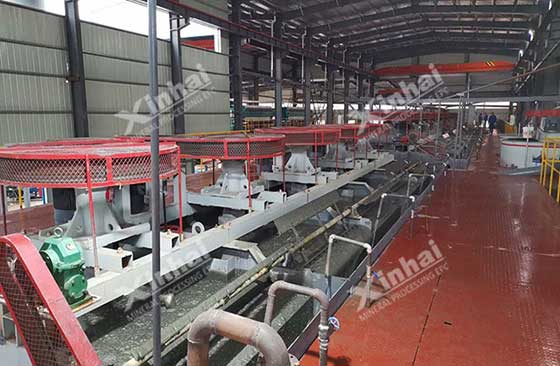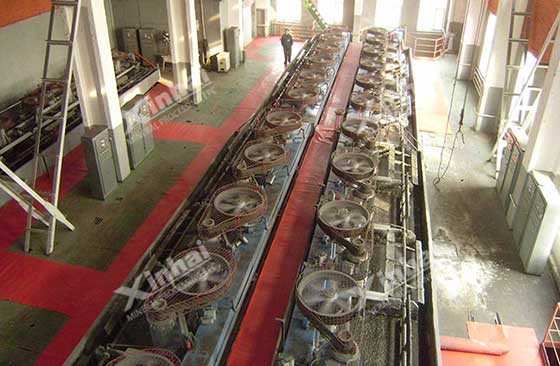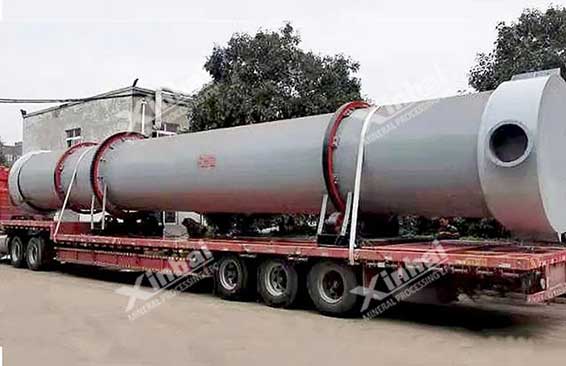
With the rapid rise of new energy sources, lithium is an important raw material for energy supply, and lithium ore resources have been pushed to the development boom. The common lithium resources are mainly pegmatite-type lithium and brine lithium. Among them, the development of brine lithium is difficult, and most of them are mainly pegmatite type. The pegmatite-type lithium ore resources can be divided into spodumene, lepidolite, lepidolite, lepidolite and lepidolite. However, lithium can be extracted by technical means mainly spodumene and lepidolite. Below you will learn about the mineral beneficiation process for these two types of lithium ores.
Spodumene is a chain-like structure of silicate minerals. Its color is mostly gray, green, dark green or yellow, vitreous luster, translucent to opaque. According to its ore properties, the beneficiation methods that can be used for spodumene include flotation method, magnetic separation method and gravity separation method (resuspension method). While flotation is often used as the main method, magnetic separation and gravity separation are auxiliary methods. Flotation mainly includes: positive flotation method and reverse flotation method.

When using positive flotation, the ore needs to be ground first, and the cationic collector (sodium hydroxide or sodium carbonate) is placed in a strong alkaline condition. Then after high concentration, strong stirring, washing and desliming for many times, fatty acid (such as oleic acid) or saponite collectors are added to the pulp to directly float spodumene. During the flotation process, no inhibitor needs to be added. Sodium hydroxide will combine with the silicates in the pulp to form glass water. It can effectively inhibit gangue minerals such as quartz and feldspar.
The lithium extraction method by reverse flotation mainly uses lime as a regulator. In alkaline medium, dextrin and starch are added to the pulp as inhibitors to inhibit spodumene. Dextrin amine cationic collectors are used to collect gangue minerals, the gangue minerals are floated first, and the tailings (in the flotation cell) are lithium concentrates.
Lepidolite (also called lepidic mica) belongs to the mica group of minerals. It is a layered silicate that is rose, purple, light purple, grayish-yellow, sometimes colorless, and nonmagnetic. Lepidolite can extract valuable metals such as lithium, rubidium, and cesium. Commonly used beneficiation methods include sulfuric acid roasting method, sulfate roasting method, limestone method, chlorination roasting method, pressure cooking method and alkali dissolution method.

The sulfuric acid roasting method is to first grind lepidolite and concentrated sulfuric acid, and then conduct acid roasting at low temperature (110~200℃). After roasting, the obtained acidified clinker needs to be cooled and then immersed in water to obtain a lithium sulfate solution.
The sulfate roasting method is to mix lepidolite with sulfate (potassium sulfate, sodium sulfate or calcium sulfate, etc.), and roast it at a certain high temperature (800~950℃), so that the lepidolite is replaced and transformed into soluble lithium sulfate. Then, water or dilute acid is added to lithium sulfate for leaching, and lithium minerals can be obtained after filtration.
The limestone roasting method is to mix lepidolite and limestone to a certain fineness, then roast at high temperature (800~900℃), and then leaching with water after cooling to obtain a lithium-containing solution.
The chlorination roasting method mainly grinds lepidolite and chlorides (sodium chloride and calcium chloride, etc.) and roasts them at a certain temperature to convert lithium and other valuable metals into soluble chlorides. Then water immersion can obtain lithium chloride solution. There are two methods of chlorination roasting: high temperature roasting and medium temperature roasting.
High temperature method: the roasting temperature should be higher than the boiling point of alkali metal chloride. During roasting, the alkali metal chlorides are volatilized (in gaseous form) and separated from impurities.
Medium temperature method: The roasting temperature is lower than the boiling point of alkali metal chlorides. Water leaching can yield solutions containing alkali metal chlorides.

Lithium extraction by pressure cooking requires first roasting and defluorination of lepidolite to transform the mineral phase. The lepidolite is then wet ground mixed with a certain amount of sodium carbonate. At a certain temperature (200°C) and a certain pressure (0.2~2MPa), the two react, and Na+ replaces Li+. Carbon dioxide is added to the leaching solution to convert lithium carbonate into soluble lithium bicarbonate, and a lithium bicarbonate solution is obtained after solid-liquid separation. Lithium carbonate can be obtained by heating and decomposing lithium bicarbonate.
The method of extracting lithium by alkali fusion is to mix concentrated sodium hydroxide solution with lepidolite, and react under certain temperature and pressure. Li+ is decomposed by concentrated alkali to form a mixed solution of aluminate and silicate. Then, minerals such as lithium and potassium in the mixed solution are exchanged into the resin using a cation exchange resin. Adding dilute sulfuric acid to the solution can replace the lithium and potassium in the resin to obtain a lithium-potassium mixed solution. Finally, sodium carbonate is used to precipitate the lithium in the mixed solution.
Spodumene and lepidolite are the main mineral resources for lithium extraction, and their extraction methods are different. In the actual concentrator, the beneficiation process of ore needs to be selected according to the ore properties of lithium. Therefore, Xinhai recommends to conduct beneficiation tests first, and design suitable lithium mineral beneficiation process and customized lithium beneficiation equipment through test analysis.
To find out more about our products and solutions, please fill out the form below and one of our experts will get back to you shortly.